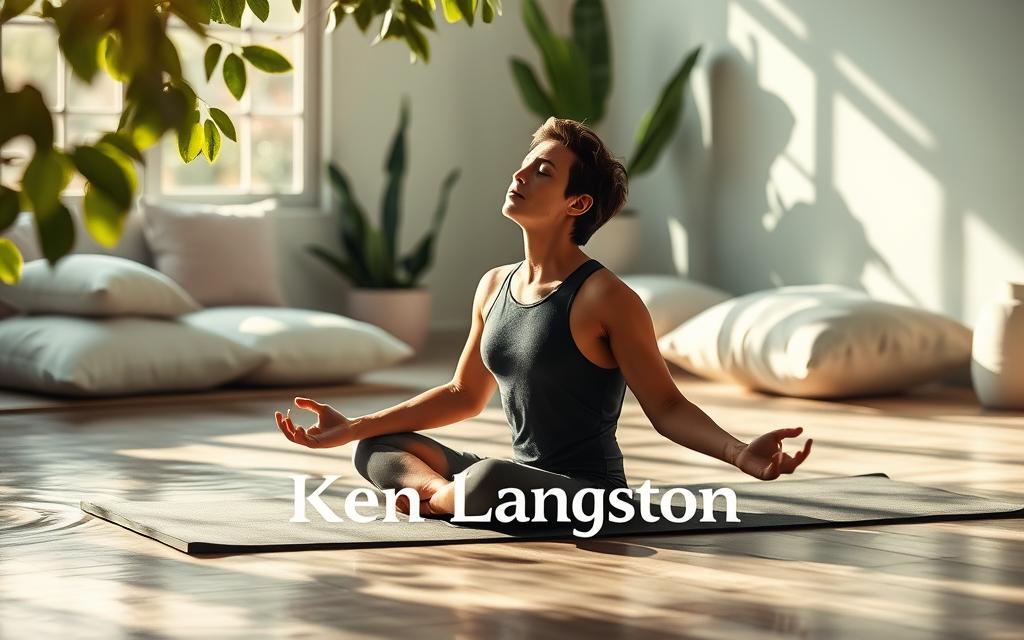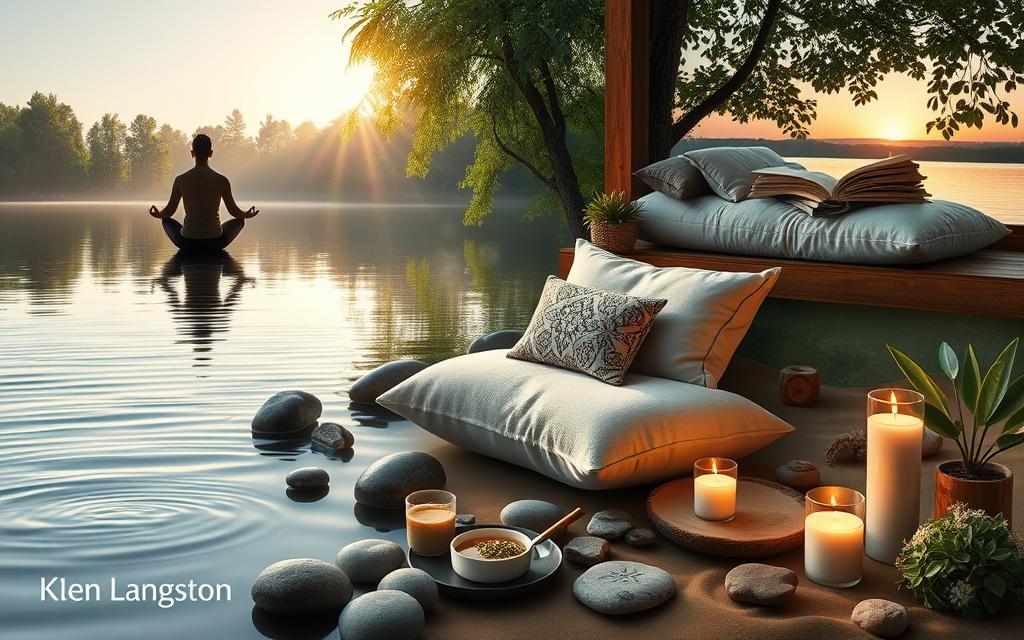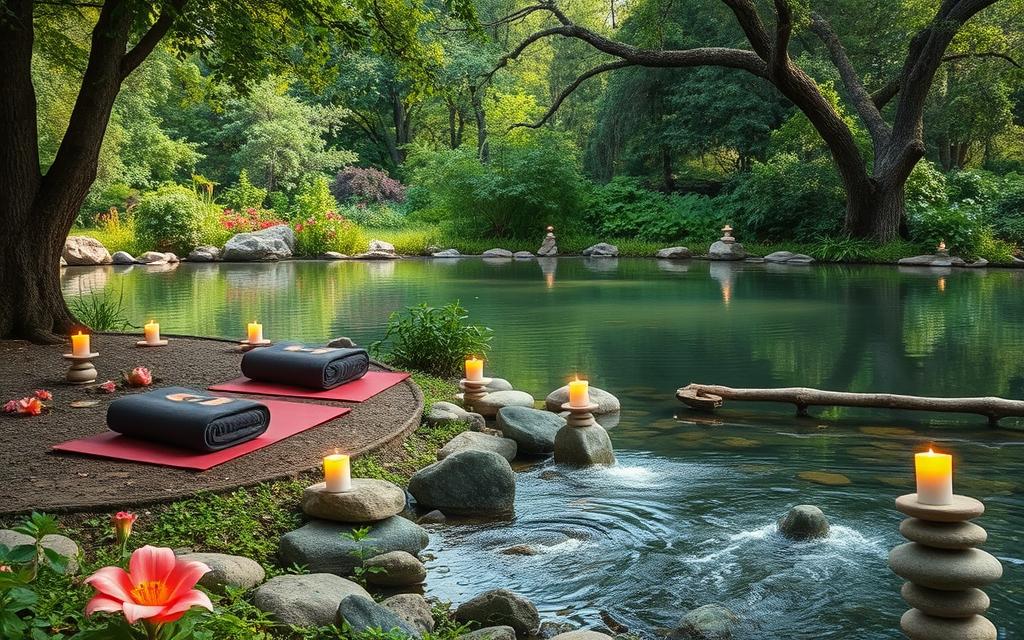Life’s stresses keep growing, making relaxation techniques more important than ever. This guide will show you many ways to find calm and refresh your mind. You’ll learn about deep breathing, meditation, and yoga. These methods can ease anxiety, calm your thoughts, and improve your well-being.
Key Takeaways
- Explore a range of proven relaxation techniques to reduce stress and find inner peace.
- Discover the benefits of deep breathing exercises and how to incorporate them into your daily routine.
- Understand the transformative power of meditation and how to cultivate a mindful mindset.
- Learn about the rejuvenating effects of yoga and how to get started with beginner-friendly poses.
- Uncover the secrets of progressive muscle relaxation and visualization techniques for deep relaxation.
- Develop effective stress management strategies and create a balanced, calming lifestyle.
- Embrace self-care practices and create a relaxing environment at home.
Mastering the Art of Deep Breathing Exercises
Discover the power of deep breathing exercises to find deep relaxation and lower stress. These methods not only fill your body with oxygen. They also greatly improve your mental health, helping you start each day with calm and focus.
Exploring Different Breathing Techniques
Explore various breathing techniques to add to your daily routine. From diaphragmatic breathing to box breathing and alternate nostril breathing, each has special benefits for deep breathing exercises, stress reduction, and relaxation.
- Diaphragmatic Breathing: Breathe deeply from your abdomen, letting your belly rise and fall with each breath.
- Box Breathing: Inhale for four counts, hold for four counts, exhale for four counts, and hold again for four counts, making a square rhythm.
- Alternate Nostril Breathing: Close one nostril with your thumb and index finger, then the other, alternating with each breath.
Try these breathing techniques to find the best one for you and your daily routine.
Incorporating Deep Breathing into Your Daily Routine
Being consistent is crucial for deep breathing exercises’ benefits. Set aside a few minutes each day for these relaxation practices. It could be in the morning, at lunch, or before bed. Make it a habit, and you’ll see how it improves your stress reduction and well-being.
“Breathing is the foundation of all meditation practices, and it’s one of the most powerful tools we have for regulating our nervous system and accessing a state of deep calm.”
The Power of Meditation for Relaxation
In today’s fast world, meditation is a key to inner peace and stress relief. It helps us focus on the present. This way, we can find deep mental well-being.
There are many types of meditation, each with its own benefits. You can try mindfulness meditation for calm or loving-kindness meditation for heart opening. There’s a method for everyone.
Starting a meditation routine can change your life. It can lower anxiety and depression. It also boosts focus, concentration, and immune function.
Look into the various meditation types and find what works for you. Maybe you like body scan meditation for relaxation or mindfulness meditation for being present. The goal is to connect with yourself and find inner peace through meditation.
Unleash Inner Calm with Yoga
Yoga is a practice that combines physical postures, breath control, and meditation. It promotes relaxation and inner peace. Whether you’re new to yoga or have been practicing for years, it can help reduce stress and improve flexibility. It also helps you become more mindful.
Beginner’s Guide to Yoga Poses
Begin your yoga journey with these gentle poses. They are great for beginners:
- Child’s Pose: This pose helps release tension in the back and neck. It encourages deep breathing.
- Downward-Facing Dog: A classic pose that strengthens the arms and legs. It stretches the back and shoulders.
- Tree Pose: This pose focuses on balance. It improves stability and concentration.
- Corpse Pose: Also known as Savasana, this pose allows your body and mind to fully unwind.
Remember to listen to your body and modify the poses as needed. Consistency is key, so try to incorporate yoga into your daily routine for maximum benefits.
Integrating Yoga into Your Lifestyle
Yoga is more than a physical practice—it’s a lifestyle. Here are some tips to help you seamlessly integrate yoga into your daily life:
- Start your day with a short yoga session to set a calming tone.
- Take yoga breaks throughout the day to stretch and recharge.
- Experiment with different styles of yoga, such as Hatha, Vinyasa, or Restorative, to find what works best for you.
- Combine your yoga practice with meditation or deep breathing exercises for a more holistic experience.
By making yoga a regular part of your lifestyle, you’ll unlock its power. You’ll reduce stress, improve physical well-being, and cultivate a deeper sense of inner calm.
“Yoga is the journey of the self, through the self, to the self.” – The Bhagavad Gita
Progressive Muscle Relaxation: A Path to Serenity
Looking for a way to ease muscle tension and find calm? Progressive muscle relaxation is your answer. This technique is simple yet powerful, leading to deep relaxation and stress relief.
Step-by-Step Guide to Muscle Relaxation
This method involves tensing and then relaxing different muscle groups. It helps reduce muscle tension and brings tranquility.
Here’s how to start:
- Choose a quiet, comfortable spot to relax without distractions.
- Start with deep breaths, inhaling through your nose and exhaling through your mouth.
- Tense your toes as hard as you can for 5-10 seconds, then release and feel the tension go away.
- Do the same for other muscle groups: calves, thighs, abdomen, chest, fingers, arms, shoulders, and facial muscles.
- As you release each group, enjoy the feeling of relaxation and let your body relax further.
By practicing progressive muscle relaxation, you can manage muscle tension, reduce stress, and feel deeply relaxed.

“Progressive muscle relaxation is a powerful tool for reducing stress and promoting overall well-being.”
Adding this relaxation technique to your daily life can change your mental and physical health. Start your journey to a more serene and balanced life.
Visualization Techniques for Relaxation
Visualization is a strong tool for stress relief and mental calm. It involves creating clear mental images to feel calm and well. You can see a peaceful place or imagine tension leaving your body. The effects of guided imagery are deep.
Try to picture yourself in a calm place. It could be a green forest, a quiet beach, or a mountain. Notice the details like what you see, hear, and feel. As you breathe deeply, let go of tension and feel relaxed.
- Visualize a serene natural setting
- Focus on the sights, sounds, and sensations
- Breathe deeply and let the tension melt away
Another way is to see stress and anxiety leave your body. Imagine each muscle relaxing as you focus on it. Start with your toes and move up, letting go with each breath.
“Visualization is the primary tool of the creative imagination.” – Shakti Gawain
Adding these visualization exercises to your day can help a lot. They can lead to deep mental relaxation and calm. Use these techniques to find true well-being.
Mindfulness: The Key to Present Moment Awareness
In today’s fast world, it’s easy to get lost in daily tasks and forget the present. Mindfulness, being fully present and aware, helps reduce stress and improve mental health. It brings a deeper sense of peace.
Cultivating a Mindful Mindset
Building a mindful mindset is worth the effort. It helps you stay present and manage emotions better. Here are some ways to live more mindfully:
- Start each day with a brief meditation or breathing exercise to center yourself.
- Pause throughout the day to take a few deep breaths and check in with your senses, noticing the sights, sounds, and sensations around you.
- Engage in present moment awareness activities, such as mindful walking or mindful eating, to stay fully present in the moment.
- Practice gratitude by taking a few moments each day to reflect on the things you’re grateful for.
“Mindfulness is simply being aware of what is happening right now without wishing it were different; enjoying the pleasant without holding on when it changes (which it will); being with the unpleasant without fearing it will always be this way (which it won’t).”
– James Baraz
By adopting a mindful mindset, you can handle life’s ups and downs better. This leads to better mental well-being and inner peace.
Stress Management: Achieving a Balanced Life
In today’s fast world, managing stress is key to a balanced life. Knowing and handling stress triggers is the first step to a healthier life. By understanding stress sources and using stress-reducing methods, we can control our well-being and find a better balance between work and life.
Identifying and Managing Stress Triggers
Stress comes from many places, like work, personal relationships, and life events. To manage stress well, we need to look closely at what causes our anxiety. Here are steps to find and tackle your stress triggers:
- Think about the situations, tasks, or interactions that stress you out the most.
- See how these stressors affect your body and mind.
- Find ways to reduce or get rid of stress, like setting limits, sharing tasks, or getting support from family and friends.
By being proactive in managing stress, you can get back your work-life balance and live a more stress-free life.
It’s also important to focus on self-care to relax and recharge. Whether it’s using relaxation techniques, practicing mindfulness, or just taking time for yourself, self-care is essential for managing stress.
“The greatest weapon against stress is our ability to choose one thought over another.” – William James
By living a balanced life, you can handle modern life’s challenges more easily and find the inner calm you deserve.
The Art of relaxation techniques
Finding calm and relaxation is an art. This guide has shown many relaxation techniques to help you relax. We’ve looked at deep breathing exercises, meditation, and yoga. Each has its own benefits for your mental and physical well-being.
There’s no single way to relax that works for everyone. What works for one might not work for another. The key is to find what works best for you.
Try mixing different relaxation techniques to create a self-care plan. You might like progressive muscle relaxation, visualization, or mindfulness. Find the right mix for you to feel calm and relaxed.

Relaxation is a journey, not a destination. By using these techniques daily, you’ll feel better right away. You’ll also improve your mental and physical well-being over time. Start enjoying the art of relaxation and unlock your mind and body’s full potential.
“The art of relaxation lies in finding the perfect balance between mind, body, and spirit.”
Embrace Self-Care with Calming Activities
Doing calming activities is key to self-care. It helps you relax, recharge, and find peace. Activities like taking a warm bath or enjoying nature can lower stress and boost well-being.
Exploring Different Self-Care Routines
Creating a self-care routine that’s just for you can change your life. Look for activities that calm you down:
- Indulge in a warm, soothing bath with calming essential oils or bath salts
- Curl up with a captivating book or listen to soothing music
- Spend time in nature, whether it’s a leisurely walk or a quiet moment in the garden
- Practice gentle yoga or meditation to connect with your inner self
- Engage in a creative hobby, such as painting, journaling, or crafting
It’s important to try different things and find what works best for you. By adding these calming activities to your daily life, you can improve your self-care, relaxation, and personal well-being.
“Taking care of yourself is the most powerful way to begin to take care of others.” – Olivia Wilde
Self-care is not a luxury, but a must. Embrace calming activities to reduce stress and enhance your well-being.
Creating a Relaxing Environment at Home
Creating a relaxing home environment is key to reducing stress and boosting mindfulness. By adding home decor that promotes calm, you can turn your home into a peaceful retreat. This supports your self-care and stress reduction.
Using color wisely is a great way to create a relaxing environment. Choose soft blues, greens, or beiges, which calm the mind. Add natural textures like wood or plush fabrics for a cozy, mindfulness-friendly space.
Elements that engage the senses also help create a relaxing environment. Use a diffuser with aromatherapy oils for pleasant scents. Soft, indirect lighting adds to the calming ambiance, promoting relaxation and stress reduction.
“A calm and peaceful environment can do wonders for your mental and emotional well-being.” – Jane Doe, Interior Designer
By carefully choosing your home decor and sensory elements, you can make a relaxing environment. Create a space that shows your personal style and values. Enjoy the benefits of a peaceful, rejuvenating home sanctuary.
Overcoming Obstacles to Relaxation
Getting relaxed can be tough, especially with busy lives and personal hurdles. It’s key to tackle these challenges to keep well. This part looks at ways to make time for yourself, manage your schedule, and see the value in relaxation.
Time is a big hurdle to relaxation. With so much to do, finding time to relax can be hard. Try adding relaxation to your daily life, like short breaks or a set time for unwinding. Saying no to things you don’t need to do can also help you find more time for yourself.
It’s also hard to focus or feel mentally resistant. A busy mind can make it hard to relax. Mindfulness, like meditation, can help calm your mind. Adding soothing things, like scents or music, can also help clear your mind and relax you.

